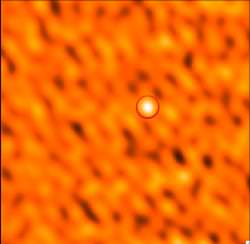We have a few pockets of star formation here in the Milky Way. But new galaxies have been discovered, 12 billion light years away, with 1000 times as much star formation. These galaxies are seen just a few billion years after the Big Bang, and they should be incredibly bright. But they aren’t; they’re hiding.
The galaxies were discovered using the AzTEC imaging camera on the James Clerk Maxwell Telescope. Under visible light, these galaxies have shrouded themselves completely in gas and dust. This camera observes in the infrared spectrum, where radiation isn’t completely obscured by dust.
The discovering astronomers first turned up several hundred candidate galaxies in the infrared and submillimeter wavelengths as part of a large survey. Then they did follow-on observations of the 7 brightest candidates using the Smithsonian’s Submillimeter array to pinpoint the exact location of each galaxy. This let them confirm that the bright candidates were indeed individual galaxies, and not clusters of galaxies blurring together.
Once they had the precise locations, they used even more powerful instruments, like Hubble, the Spitzer Space Telescope, and the Very Large Array of radio telescopes. The galaxies were hidden to Hubble, but detectable by Spitzer, which could pierce through the dust in the infrared spectrum to see the stars in the galaxy. The Very Large Array could only see two of the brightest galaxies.
Astronomers believe these galaxies have such huge levels of star formation because they have recently undergone mergers and collisions. The source of the infrared radiation is actually very compact, and the galaxies could be evolving into quasars.
Original Source: CfA News Release

